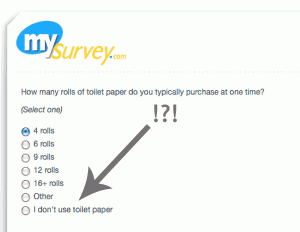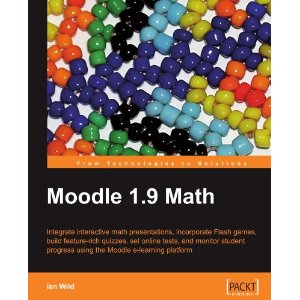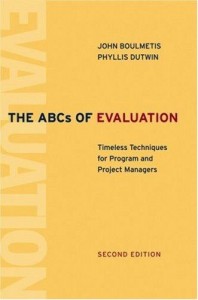Posts tagged edtech505
An Evaluation of Moodle as an Online Classroom Management System
0I’ve finished an evaluation of how our district uses Moodle, and areas where we can improve. You can read the report below.
Over the next few weeks, I’ll be releasing some follow-ups to this evaluation. Addendums, if you will. I was originally planning to supply personal assessments of each participating online course in the initial report, using a rubric for hybrid course design. After some thought I scratched this idea, because much of the rubric falls outside the scope of the district’s objectives for using Moodle, which were included in the report from the outset.
Instead, I will be delivering each a brief mini-report to teachers who participated in the survey (there were 17), with suggestions and recommendations stemming from a combination of the rubric and the survey assessments, tailored specifically to your courses and instruction.
There’s a few things I’ve learned, that I’ll have to remember for the next time we do an evaluation like this.
- Don’t underestimate your turn-out. I was expecting 100, maybe 200 survey participants tops. What I did not expect was receiving 800 survey submissions that I had to comb through and analyze. There were some duplicate data that had to be cleaned up as well, since a few of you got a little “click-happy” when submitting your surveys. I also had to run some queries on the survey database to figure out what some of the courses reported in the student survey actually were, since apparently students don’t always call their courses by the names we have in our system. Since this was a graduate school project, there was a clear deadline that I had to meet, and it was a little more than difficult to manage all that data in the amount of time I had. I should have anticipated that our Moodle-using teachers, being the awesome group they are, would actively encourage all their students to participate in this project. I will not make that mistake again.
- Keep qualitative and quantitative data in their rightful place. Although I provided graphs with ratings on each of the courses, I had to remind myself that these were not strict numerical rankings, as they were directly converted from Likert scaled questions. The degrees between “Strongly Disagree” and “Strongly Agree” are not necessarily the same in everyone’s mind, so when discussing results, one has to look at qualitative differences and speak in those terms. For example, if the collaboration “ratings” for two courses are 3.3 and 3.5 respectively, one can’t necessarily say that people “agreed more” with Course 2 than Course 1. There may be some tendencies that cause one to make that assumption, but one shouldn’t rely on the numerical data alone. To brazenly declare such a statement is hasty. If the difference had been significant, such as 1.5 vs. 4.5, then there would likely be some room for stronger comparisons.
- Always remember the objectives. When analyzing the data, it’s easy to get sidetracked with other interesting, but ultimately useful data. For example, a number of students and teachers complained about Moodle going down. This was a problem awhile ago, and it caused some major grief among people. However, it was not relevant to any of the objectives for the evaluation, even though it was tempting to explain/comment/defend this area. I take it personally when people criticize my servers! (Just kidding.)
- If the questions aren’t right, the whole evaluation will falter. Even though I had the objectives in mind when I designed the survey, I still found it difficult to know which were the right questions to ask. I’ve been assured that this aspect gets easier the more you do it. In the end, there was some extraneous “fluff” that I simply did not use or report on, because it wasn’t relevant (e.g. “Do the online activities provide fewer/more/the same opportunities to learn the subject matter?” My initial inclination was to include this in the Delivery, but when I finally looked at the finished responses, I realized it didn’t really fit anywhere and wasn’t relevant to any of the objectives.
Right now, being the lowly web manager that I am — and I only use the term “web manager” because “webmaster” is so 1990s; I don’t actually “manage” anyone — I don’t get many opportunities to do projects like this. But I’m aspiring to do more as a future educational technologist. Evaluations are more than just big formal projects … they underscore every aspect of what we as educators do. Teachers would do well to perform evaluations of their own instructional practices. When we add new programs or processes in our district, evaluations should accompany them. And as I complained in my mini-evaluation of BrainBlast 2010 a few days ago, all too often the survey data we gather just aren’t properly analyzed and used. We have some of the brightest minds in the state of Utah working in our Technical Services Department, but often we just perform “mental evaluations” and make judgments of the direction things should go, when we would do well to formalize the process, gather sufficient feedback, and use it to make informed decisions.
Update on the Moodle Survey
0 Last week I invited all our Moodle-using teachers and students to take a survey about their usage of Moodle as an online course management system and supplement to in-class instruction. The response has been great. So far (as of November 23, 9:30pm), 652 students and 17 teachers have participated. The survey was supposed to close today, but at the request of the teachers and students, I am leaving it open until November 30.
Last week I invited all our Moodle-using teachers and students to take a survey about their usage of Moodle as an online course management system and supplement to in-class instruction. The response has been great. So far (as of November 23, 9:30pm), 652 students and 17 teachers have participated. The survey was supposed to close today, but at the request of the teachers and students, I am leaving it open until November 30.
The survey questions assess four categories: (1) Participant Attitudes, (2) Collaboration, (3) Instructional Preparation, and (4) Instructional Delivery. There are a few goals I’m keeping in mind. One is to help determine the collaborative effect of our usage of Moodle. During the last BrainBlast, we taught a session to (almost) every secondary teacher in attendance: “Creating Collaborators with Moodle.” This begs the question, “Just how well are we currently using Moodle for collaboration?” Where can we improve? Our teachers have had the opportunity to put what they learned in the Moodle class into practice, so has the collaboration aspect improved? The survey addresses this.
Another goal is to address if Moodle actually reduces instructional preparation time. Our teachers have commonly criticized Moodle for being too time-consuming. This is a valid concern, and there are questions addressing the preparation time of the two major activities our teachers use in Moodle: assignments and quizzes. The delivery aspect of Moodle is important, too. Are students more engaged when they use Moodle? Is it easier for them to submit their homework? Does using Moodle save them time as well?
Originally, I was planning on correlating Moodle usage with academic performance, but after consulting with my professor, Dr. Ross Perkins, I realized that there are too many factors involved to even suggest some sort of link between the two. Moreover, the instruction itself is key, not necessarily the tool of delivery. What’s more, I think such a question starts crossing territory into more of a research project than an actual evaluation. It would be incredibly useful to research and establish best practices for online course delivery; the present scholarship in this area is huge and constantly evolving, but a lot of work remains to be done. However, it is outside the scope of this evaluation.
Most of the Moodle survey uses a Likert scale (Strongly Agree to Strongly Disagree) for the questions. There’s considerable debate over whether scales like this should employ a middle ground (e.g. Neither Agree nor Disagree) by providing an odd number of answers, or force participants to choose a position by providing an even number of answers. After tossing the two options back and forth in my mind, I decided on providing a middle option for the questions. I’m wondering now if that was a mistake. I believe it introduces a degree of apathy into the survey that, in hindsight, I didn’t really want. A lot of the participants are choosing “Neither Agree nor Disagree” for some of their answers, when I suspect they probably mean “Disagree.”
Ultimately, though, the data are still valuable. Apparently, most students do not feel that they are given many opportunities to collaborate in Moodle. Teachers generally agree that they don’t bother to provide these opportunities for collaboration. Perhaps as a follow-up, I should ask the teachers why they don’t provide collaborative opportunities, especially those teachers who attended the BrainBlast session.
 The data also indicate that both students and teachers generally agree that Moodle saves time in both preparation and instruction. The disagreements here come mainly from math teachers who complain about Moodle’s general lack of support for math questions (DragMath is integrated into our Moodle system, but this isn’t enough), and the inability to provide equations and mathematical formulas in quiz answers. This is undoubtedly worth further investigation. I came across a book on Amazon (Wild, 2009) that may provide some valuable insights.
The data also indicate that both students and teachers generally agree that Moodle saves time in both preparation and instruction. The disagreements here come mainly from math teachers who complain about Moodle’s general lack of support for math questions (DragMath is integrated into our Moodle system, but this isn’t enough), and the inability to provide equations and mathematical formulas in quiz answers. This is undoubtedly worth further investigation. I came across a book on Amazon (Wild, 2009) that may provide some valuable insights.
The participants are prompted to provide open-ended comments as well. Answers fell all across the spectrum, from highly positive (e.g. “I love taking online courses; it’s easy, organized, and efficient…”) to extremely negative (e.g. “I hate everything about it; online schooling is the worst idea for school…”). The diverse answers will be addressed in the final report.
The survey isn’t the only measurement tool I’m using. I’m also going to employ a rubric to assess each online course represented in the survey. There are few enough (in this case, about 20) that this is a reasonable amount to assess within the given time. After that, I just have to write up the final report, create some graphs of the data, analyze the results, and provide recommendations.
References
Wild, I. (2009). Moodle 1.9 Math. Packt Publishing.
Analyzing the Problem
0 We solve problems every day. Sometimes the problems are simply figuring out where you left your car keys. Other times, it’s determining the best way to reach the unique needs of your students. Often we solve these problems without really thinking through the process. We just mentally “connect the dots” and arrive at conclusions. The conclusions may not necessarily be the best ones, or we may not always explore all the options at hand. In most cases, for mundane tasks, it’s not really necessary. When you can’t find your car keys in one location, you naturally move on to another until they’re located. But some situations may warrant a more in-depth analysis of the problem.
We solve problems every day. Sometimes the problems are simply figuring out where you left your car keys. Other times, it’s determining the best way to reach the unique needs of your students. Often we solve these problems without really thinking through the process. We just mentally “connect the dots” and arrive at conclusions. The conclusions may not necessarily be the best ones, or we may not always explore all the options at hand. In most cases, for mundane tasks, it’s not really necessary. When you can’t find your car keys in one location, you naturally move on to another until they’re located. But some situations may warrant a more in-depth analysis of the problem.
Analyzing a problem is the intermediary step between recognizing the problem and arriving at a solution, and it involves using data collection and forming decision-making strategies. Defining clear goals and objectives is important, too. For BrainBlast 2010 last summer, we had all the attendees participate in a survey on the final day of the conference. The goal was to collect data to enhance the quality of instruction for future conferences, and we collected some valuable information to this end, through a combination of Likert scale questions, and prompted constructive criticism. With these data, we can form the necessary decisions to improve future BrainBlasts, and avoid repeating any mistakes we made in the past.*
An evaluator must assess aspects such as the needs of the program and its users. It’s important to be aware of the different data-collection tools at one’s disposal as well. My own forthcoming Moodle evaluation will be largely interview-based, with some backend data collection assessing general academic performance averages and usage of online course activities. Interviews in particular are useful formative evaluation tools. It’s important to not neglect formative evaluation during a program, as it can reveal scenarios, ideas, and possible venues for improvement before the conclusion.
Objectivity is important as well when analyzing a problem. After all, if an evaluation isn’t objective and free of bias, it is worthless. While it’s likely not possible that an evaluator can completely cast their biases aside, especially when offering professional recommendations, it’s important they make every effort to do so. Also, detailing the steps the analysis took and the efforts to collect objective data goes a long way.
* An analysis of the BrainBlast 2010 survey results will be posted in a few days. (Update: survey results are now available.)
Analysis of Three Evaluation Reports
0The USOE 2005 Summative Evaluation Report reads more like a commentary than an evaluation, and is very poorly executed. Data analyses are not conveyed in any meaningful forms or visualizations. Numerous spelling and grammar errors persist. The report doesn’t seem to address any particular objectives or self-defined goals in each program, and is highly disorganized and difficult to follow.
The data analysis for Everyday Math contains excellent visuals. A valid point is raised that performance data in education is difficult to evaluate, since there is often not a control group. Both the parent and teacher surveys cover the most pertinent aspects involved in the program, and are in accordance with the National Mathematics Advisory Panel’s report in Appendix B. However, the recommendation to pilot alternatives to Everyday Math is not necessarily the next logical step based on the evidence. The evaluation consists primarily of attitude assessments, rather than performance assessments. There are multiple reasons why a program would fail, and Everyday Math’s problem might simply be due to improper training among the teachers, a factor which wasn’t considered in the report. The Executive Summary itself isn’t necessarily supported by the text, and at best refers to vague references to math scores consistently improving over time, and the lack of evidence that Everyday Math leads to better performance.
The Technology in Teacher Education—Nevada: Project TITE-N report contains a diverse selection of data which appears to adequately cover the pertinent topics relevant to pre-service teachers. Measurement tools are very well-documented, and referenced frequently throughout the text, particularly in the informative visual displays of the data. There is, however, the necessity to familiarize oneself with the abbreviations before reading the data analyses charts. Figure 10 contains colors that are too close to distinguish, and Figure 14 contains blank items in the legend. Overall, the evaluation was well-done, with dissimilar groups being surveyed to ensure breadth of applicability, and with conclusions that accurately match the data portrayed.
Plans for an Evaluation of Weber's Moodle System
0I’m conducting an evaluation of WSD Online, our district’s Moodle system. Right now, we use this as our online classroom management tool. We’re just barely piloting fully-online courses, but that’s not what I’m evaluating. Right now more than a few of our teachers use Moodle as a supplement to their in-class teaching. I’ve decided to evaluate four primary areas regarding our use of Moodle:
- How student engagement in our classes is impacted when Moodle is used
- If the most popular activities our teachers use in Moodle (in ascending order: quizzes, assignments, and forums) actually reduce teacher preparation time
- How the usage of Moodle activities impacts attitudes among teachers and students, such as quiz-building, assignments, over the traditional forms of delivery, and
- How Moodle affects the academic performance of students
I’m interested in hard data on how the groups perform compared to non-Moodle-using groups. We only have between 20 and 30 teachers actively using Moodle, which isn’t significant enough for gathering districtwide data. However, I can gauge the results on an individual course basis by comparing academic performance of the students in the teacher’s class with the usage of Moodle, to how the students performed before the teacher used Moodle to supplement the learning environment.
With the help of some of my classmates I’ve evaluated a few other web sites, or web-based learning environments to be exact. A rubric designed by Baya’a, Shehade, & Baya’a (2009) was used to assess usability, content, value, and vividness of each site, to produce a criterion-referenced evaluation report. It did help me understand some of the strengths of using a rubric to assess content, when there are identifiable criteria to evaluate. It also helped me recognize this is probably not the way I want to go for the WSD Online evaluation, since any criteria I assign will be fairly arbitrary at this point. The norm-referenced approach will probably be more useful, because I can directly compare our Moodle-using teachers and students to non-Moodlers.
References
Baya’a, N., Shehade, H. M., & Baya’a, A. R. (2009). A rubric for evaluating web-based learning environments. British Journal of Educational Technology, 40(4), 761-763.
Tips for Writing a Summative Evaluation Report
0 There is no “right” or “wrong” way to write a summative evaluation report. But there are good practices. I’ve prepared a list that summarizes what I’ve learned about evaluation reports, and some techniques for writing an effective one. In general, this list is mainly intended to help me, as these are points I thought were especially poignant and conducive to a good written report. The list is divided by suggested sections of the document.
There is no “right” or “wrong” way to write a summative evaluation report. But there are good practices. I’ve prepared a list that summarizes what I’ve learned about evaluation reports, and some techniques for writing an effective one. In general, this list is mainly intended to help me, as these are points I thought were especially poignant and conducive to a good written report. The list is divided by suggested sections of the document.
Summary
- This is the “condensed” version of your entire report. Write this section last, to give yourself time to mentally process and work through all the elements of your evaluation, and get a clear picture in your head of the most important points.
- Remember, some will only read the summary — and in many cases these may unfortunately be the key figures in the organization or among your stakeholders — so keep it concise. Preferably no more than two pages.
Introduction
- Remember who the stakeholders are, and for whom the report is being written. Target the introduction and only write what will interest them.
- Write the purposes for the evaluation. Answer questions like: “What did the evaluation intend to accomplish?” “Why was an evaluation necessary?”
- Write about the program being evaluated. Identify the origins of the program, objectives and goals, internal activities, technology used, successes, shortcomings, any staff members involved, and so on. This will make sure the evaluator understands what’s going on.
- Implicitly identify the evaluation model being used. This will be addressed in more detail in the next section.
- Briefly outline what will be covered in the rest of the report here.
Methodology
- Describe the sampling method(s) used. Who is the target population, and how was the sample randomized (if it was randomized)?
- Describe the evaluation model (goal-based, decision-making, discrepancy, etc.), and why it was chosen.
- Describe the data sources, and the instruments used to obtain the data. Explain the right tools for the job. If you gathered qualitative data, describe the interviews, observation, etc. and gathered nominal and ordinal data. If you gathered quantitative data, describe the measurements that gathered interval and ratio data. Include the specific measurement tools in appendices, if necessary.
- Describe the data analysis procedures used, such as statistical calculations and how scores were derived from the data.
- Keep graphs and charts to a minimum, as these will be presented in the next section.
Results
- Outline the objectives one by one, and describe how the program accomplished those objectives.
- Refer to the instruments used in the results, and make it clear which instruments were used to achieve which results.
- Descriptive and well-designed tables and charts are always nice. The more visually explanatory a table or chart is, the better, because it means you need less of a verbal description.
- Write the results only after all the data have been collected and organized into the visual displays, or analyzed for content.
- Describe the implications the results have for the targeted stakeholders.
- Make sure both positive and negative results are written. This may include cost/time/productivity benefits or disadvantages. Make sure any personal biases don’t skew the description of the results.
- Verify that the program actually caused the results, and that extraneous unanticipated factors did not contribute to the results.
Recommendations
- This section can act as both a conclusion as well as a place to put professional recommendations.
- Ensure that every objective and goal stated in the introduction is addressed.
- Although you made sure not to let your biases skew the results, you still have your own biases. Tactfully make clear your own biases in the report, and let the target readers know why your recommendations may differ from another evaluator’s. Justify your recommendations as best as possible, but make sure your unique perspective is clearly presented.
Evaluating BrainBlast
0 I’m getting close to wrapping up my reading of a rather interesting and insightful book: The ABCs of Evaluation (Boulmetis & Dutwin, 2005). It’s been an eye-opener for me, and has caused me to rethink how a lot of our professional development programs are evaluated.
I’m getting close to wrapping up my reading of a rather interesting and insightful book: The ABCs of Evaluation (Boulmetis & Dutwin, 2005). It’s been an eye-opener for me, and has caused me to rethink how a lot of our professional development programs are evaluated.
I’ve been writing a report about the survey results we collected last month at BrainBlast, our district’s annual technology conference. It’s a fantastic event that we put on every year in the summer. Up to 300 teachers and administrators attend the conference, participate in hands-on workshops, and win cool prizes. And every year we try to get good feedback about how the year’s conference went, by encouraging everyone to take a survey.
I started my report of BrainBlast 2010’s survey back in August, without realizing what I was doing was an evaluation report. However, I’ve since realized I made quite a few mistakes in my methodology, and I’ll probably need to start again from square one. For one, my evaluation was based largely on data that was improperly quantified. We collected some ordinal data in that we prompted each participant to rate their courses as Poor, Fair, Good, or Outstanding, but then I converted these to numerical quantities — 1 for Poor, 2 for Fair, 3 for Good, 4 for Outstanding — even though the division between each level is not necessarily equal. A lot of my report was based on this faulty assumption, and I made the same mistake a couple years ago in my comments about the BrainBlast 2008 survey. As a result I’ll need to reassess the data we collected this year.
In general, the survey we administered wasn’t really comprehensive and designed with a full-scale evaluation in mind, but I’ll do the best I can. Boulmetis & Dutwin (2005) outline a good format for writing evaluation reports, consisting of sections for a summary, evaluation purpose, program description, background, evaluation design, results, interpretation and discussion of the results, and recommendations. I think this is a good model to follow for any evaluations. At the very least it will be good practice for me as I hone my evaluation skills, and next year I’ll make sure I play a more important role in how we evaluate BrainBlast. Putting on BrainBlast is a significant financial investment for the district, albeit a very worthwhile one. It’s important that we make the most of how we conduct this valuable form of professional development.
References
Boulmetis, J., & Dutman, P. (2005). The ABCs of evaluation. San Francisco, CA: John Wiley & Sons.
Evaluating Online Professional Development
0I’ve been musing over how to revise the online professional development offerings in our district for awhile. Our district is getting close to the point where we can start implementing changes that ensure meaningful learning. I’ve been studying different aspects of evaluations, namely the basics of how to conduct them and collect data.
A goal-based evaluation would be ideal for our online inservice. This type of evaluation measures efficiency (the timeliness in which the learning is conducted), effectiveness (whether the participants actually learned the material following the instruction), and impact (how their behavior is affected long-term). There is value to both qualitative and quantitative measurement tools, and the data we gather should consist of both.
It’s important to understand the stakeholders involved as well. I would like to tie our online inservice with curricular standards, particularly if any online learning is extended to students, and not just employees. We already allow our teachers to earn state CACTUS credit through our inservice portal, but I think without proper assessments the credit given does not demonstrate actual learning.
It’s strange that we have overlooked evaluation in a lot of our online professional development. It seems obvious now. We should set clear goals and objectives, outlining what we wish to accomplish. Evaluation should occur every step of the way, through both formative and summative assessments. Self-directed courses should be kept to a minimum, since it can be more difficult to collect formative assessment in this venue. In directed courses, the instructor can observe how the learners interact with the material, and take notes. I tend to favor project-oriented learning, so I don’t necessarily prefer quiz-based summative assessments. Final projects which effectively demonstrate all the material learned in the online class could be constructed instead, and assessed through a rubric. Another assessment, perhaps conducted through observation only, should also provide a means to determine the impact of the training one, three, or six months down the road. Has the material been applied to the participant’s instructional practices? Has their behavior changed? For example, if they participated in introductory blog training, are they now actively using their blog for instructional purposes and parent outreach?
Determining exactly how to form these assessments is what I’m still unclear about, and I still struggle with deciding how to form the questions in an evaluation, and knowing what to ask. I would like to focus more and get some practice determining and writing questions that lead to clear process descriptions and goal statements.
